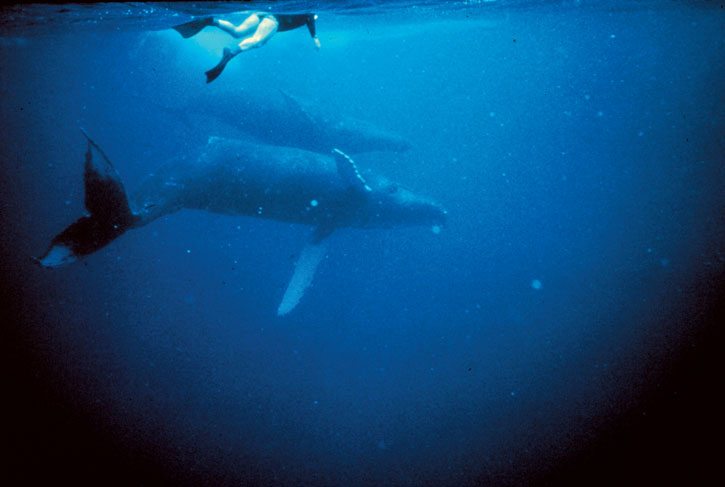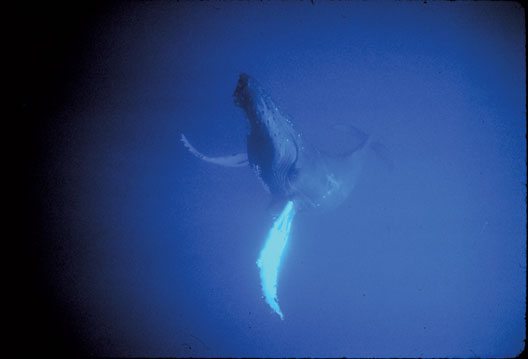Whales: The largest creatures ever to have lived on this planet; outgrowing and outliving dinosaurs and woolly mammoths. Growing up to 98-feet long, the colossal 190 tonne Blue Whale beats them all.
Yet today whales stand alongside the growing number of species that are endangered and in need of protection. Throughout history whales have fascinated us mere mortals. Books, from the Bible to Moby Dick, have made legends of these leviathans of the sea.
Whales have survived everything this planet has thrown at them including an ice age and mass slaughter that pushed some species to the edge of extinction.
While the world has become easier to travel around, more people desire an encounter with these legends themselves. A 2009 study by the International Fund for Animal Welfare (IFAW) estimated that 13 million people went whale watching globally in 2008, generating $2.1 billion per annum.

This year, I decided to join them. In February I booked with Salt Cay Divers in the Turks and Caicos Islands. I chose them for their clear commitment to the conservation of whales. Describing their interactions as ‘soft’, they’ll only enter the water if the conditions are right for the whales. And their ongoing research into the effects whale-watching tours may have on the mammal put my mind at ease.
By running trips this way the tourists get a more wholesome experience, while if the whales feel safe and happy they’ll want to return. Salt Cay Divers must be doing something right because research suggests that Humpbacks are not just passing through this area on their way south, some are staying behind to breed.
In the Caribbean, we’re blessed with the presence of North Atlantic Humpbacks (Megaptera Novaeangliae) which translates to ‘big-winged New Englander’. Humpback whales migrate annually between their summer feeding grounds in the North Atlantic and their winter breeding grounds in the Caribbean. The largest known breeding and calving areas are off the coast of the Dominican Republic, the Silver Shoals to the north of the island, and Puerto Rico. Surprisingly, whales appear to share a few similar characteristics with us: they’re very sociable, they can live to be 80-years-old, and their flukes (the fins at the end of their tail) are unique to each whale, each having a variable pattern just like our fingerprints.
Their most endearing quality has to be the protective nature towards their young. On average, females give birth every two to three years, but some can give birth annually, always birthing just one calf after a gestation period of 11-12 months. At birth, a calf can weigh two tonnes and average 13-15ft in length, growing at a rate of around 18 inches every month. The mothers are so protective they will not abandon their calf, even in the most dangerous situations. Early hunters took advantage of this, first killing the calf, then the mother as she refused to leave her calf’s side.

My encounter and the moment it all became clear
I was feeling nervous, excited, and for some reason even a bit fearful. As we set off on the little wooden speed boat from the tiny harbour at Salt Cay, we were all assigned points of the clock for ‘spotting’. I got four o’clock and, as we pounded over the waves, I tried not to take my eyes off the horizon.
“It’s difficult when the water’s rough, but keep watching and you should see them spout,” said our guide. After half an hour the adrenaline started to fade and was replaced with panic that I’d never get a chance to see a whale. But ten minutes later my partner Andy jumped out of his seat. “Over there! Six o’clock!” he roared, frantically pointing.
The Captain observed for a moment, approached a little closer, and then shut off the engines, explaining that he would let the boat drift forward. As we got closer, we all readied our fins and masks.
Then the signal came to enter the water as silently as possible, sliding overboard rather than jumping in. We swam together in a tightly formed line, approaching the general area where we saw the last spray of water. I knew we were getting very close, but I still wasn’t seeing any evidence. The water was only 50ft deep but due to the rough weather of the last few days, visibility was poor and I couldn’t see more than about 15ft in front of me.
Looking down I could see black rocks and the occasional white sandy patch, when all of a sudden I saw an eye peering at me from out of the rocks. Like a jigsaw puzzle suddenly revealed, I realised that the rocks and sand was actually a whale and I was swimming just 15ft from it. I traced the eye backwards along its body until I saw the tail flicking gracefully behind.
As I fumbled around trying to turn on my camera without taking my eyes off the whale, I noticed another, bigger eye staring at me. That’s when the picture became clear – I’d been amazed at the size of the calf, believing that to be a fully grown whale. Now I was seeing the mother, with the calf playing alongside her and I could see she was three times her size. It was a breath-taking and exhilarating moment. I couldn’t stop looking at her soulful eye, so small for the size of her body.
Later, as we celebrated with sunset drinks ashore from where we could see our 34ft catamaran at anchor, it dawned on me just how big the adult whale had been – approximately 1.5 x the length of our boat – Staggering!
Encountering whales is a magical experience, but one that needs to be done with sensitivity and care. The whale-watching guidelines will help ensure that both you and the whales will be happy should you be lucky enough to encounter them while cruising.

WHALE WATCHING ETIQUETTE
• Vessels should approach slowly, carefully and quietly (keep engine noise to a minimum).
• Maintain a respectful distance from the animal so that they don’t feel threatened or stressed.
• Avoid ‘fencing in the whales’. This includes blocking them between boats/too close to the shore/chasing after them or getting between a mother and calf.
• If whales change their direction three to five times it means they are feeling hassled and becoming stressed. Simply maintain your distance and allow them their space. Disturbed whales will swim away, cutting your viewing time short.
• When operating a vessel, move parallel to the whales to avoid approaching them head-on. Surprised whales may show aggression and become very dangerous given their size.
• Mothers and calves are tired and more likely to be ‘spooked’. They require even more consideration.
Source: Turks & Caicos Island Government Department of Environment and Maritime Affairs (DEMA) www.gov.tc/dema
Katie Gutteridge is an adventure traveller. Her past trips include an overland self-drive from England to South Africa with partner Andy. Last year the couple bought a catamaran and learned how to sail on their way south from Florida. Their home is in rural England.




